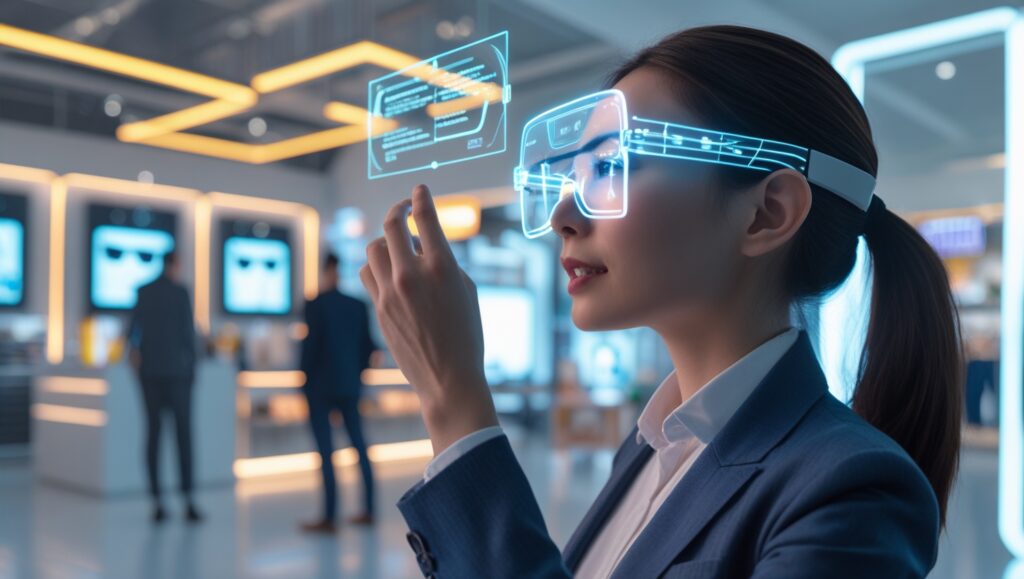Introduction
Augmented Reality (AR) is revolutionizing industries by blending digital elements into the real world through mobile devices, smart glasses, and headsets. Businesses across retail, real estate, healthcare, education, and marketing are leveraging AR to enhance customer experiences, drive engagement, and increase conversions.

With 5G networks and AI-powered AR advancements, businesses can now deliver real-time, immersive experiences to their audiences. This article will guide you through the process of implementing AR for business and marketing in 2025.
Step-by-Step Guide to Implementing AR for Business
Step 1: Identify Your Business Use Case
Before investing in AR, determine how it can add value to your business. Some key applications include:
1. Retail & E-commerce

- Virtual Try-Ons – Allow customers to see how clothes, glasses, shoes, or makeup look on them before buying. (e.g., Sephora Virtual Artist, Nike Fit)
- 3D Product Previews – Let customers place furniture in their homes before purchasing. (e.g., IKEA Place)
2. Real Estate & Architecture

- Virtual Property Tours – Buyers can explore properties remotely through AR walk-throughs.
- AR-Enhanced Blueprints – Architects and engineers can visualize structures in 3D.
3. Healthcare & Medical Training
- AR Surgical Assistance – Surgeons can overlay vital patient information during operations.
- Medical Education – AR models help students understand human anatomy interactively.
4. Education & Training
- Interactive Learning – Schools and online platforms use AR for engaging science experiments, history lessons, and skill-based training.
- Workplace Training – Employees in industries like aviation, manufacturing, and healthcare train using AR simulations.
5. Marketing & Advertising

- AR Filters & Gamification – Brands create AR-based games or face filters on platforms like Snapchat, Instagram, and TikTok.
- AR-Enhanced Print Ads – Users scan print ads with their phone to see a 3D version of the product.
Step 2: Choose an AR Development Platform
Selecting the right AR platform depends on your use case. Here are the top platforms:
| Platform | Best For | Examples |
|---|---|---|
| ARKit (Apple) | iOS AR experiences | AR navigation, mobile games, shopping apps |
| ARCore (Google) | Android AR development | AR shopping, education apps |
| 8thWall | Web-based AR | No app needed, browser-based AR experiences |
| Spark AR (Meta) | Social media filters | AR for Instagram & Facebook |
| Vuforia | Industrial AR applications | Manufacturing, training, automotive |
Step 3: Create an Engaging AR Experience
Your AR experience should be interactive, immersive, and valuable. Follow these best practices:

✅ Focus on User Experience (UX)
- Keep it simple – Users should easily navigate and interact with AR features.
- Make it accessible – Ensure AR is available across different devices and platforms.
✅ Use AI for Personalization
- AI-powered AR adapts experiences based on user preferences.
- Example: Sephora’s AI-powered Virtual Artist recommends shades based on a user’s skin tone.
✅ Optimize for Speed & Performance
- Compress 3D assets to ensure faster loading times.
- Use cloud-based rendering for high-quality AR experiences without device limitations.
Step 4: Integrate AR with Your Marketing Strategy
To maximize engagement, deploy AR across multiple marketing channels:

🎯 1. Social Media AR Marketing
- Instagram & Snapchat AR Filters – Create interactive branded filters (e.g., McDonald’s AR filters for promotional campaigns).
- TikTok AR Challenges – Brands use AR effects for viral user-generated content.
🛍️ 2. AR in E-commerce
- Virtual Showrooms – Customers view products in 3D before purchase (e.g., Lenskart’s 3D Try-On).
- AR Shopping Ads – Google and Meta allow AR-based ad campaigns.
📢 3. AR-Enhanced Print & Outdoor Ads
- Users can scan billboards or magazines with their phone to see an animated 3D ad.
- Example: Pepsi’s AR bus stop campaign amazed commuters with realistic AR animations.
🎮 4. Gamification in AR Marketing
- AR-based scavenger hunts and rewards drive engagement.
- Example: Pokémon GO’s success in location-based AR gaming.
Step 5: Track Performance & Optimize
Measure the success of your AR campaigns using:
✅ Engagement Metrics – Time spent interacting with AR content.
✅ Conversion Rates – How many users complete a purchase after using AR?
✅ Customer Feedback – Gather reviews and improve user experience.
Use tools like Google Analytics (AR-specific tracking) and Meta Business Suite (AR campaign analytics) to analyze performance.
Benefits of Using AR for Business & Marketing

✅ Increases Customer Engagement – AR content has higher interaction rates than traditional ads.
✅ Boosts Conversions – Virtual try-ons reduce hesitation and improve purchase confidence.
✅ Enhances Brand Awareness – AR campaigns stand out in crowded markets.
✅ Reduces Product Returns – Customers make more informed decisions with AR previews.
✅ Future-Proofs Your Business – AR is growing rapidly, making it essential for digital transformation.
FAQs (Frequently Asked Questions)
Q1: Do I need an app to use AR for my business?
No. WebAR (e.g., 8thWall, ZapWorks) allows AR experiences via browsers, eliminating the need for an app.
Q2: How expensive is AR implementation?
Costs vary:
- Basic AR filters (Instagram, Snapchat): $500–$5,000
- WebAR experiences: $5,000–$50,000
- Advanced custom AR apps: $50,000+
Q3: Is AR only for big brands?
No! Small businesses can use affordable AR tools like Spark AR and WebAR to create interactive experiences.
Q4: How does AR impact customer behavior?
Studies show that AR experiences increase engagement by 200% and reduce return rates by 30% for e-commerce.
Q5: What is the future of AR in business?
- AR-powered smart glasses (e.g., Apple Vision Pro, Meta Quest 3)
- AI + AR for hyper-personalization
- AR Cloud for persistent, real-world AR experiences
Conclusion
Augmented Reality is reshaping business, marketing, and customer experiences in 2025. Whether you’re in retail, real estate, healthcare, or education, AR technology can boost engagement, improve sales, and enhance brand awareness.
With AI advancements, 5G connectivity, and AR cloud technology, the possibilities are endless. Now is the time to start integrating AR into your business strategy! 🚀
Discover the best ways to monetize AI-generated art and turn creativity into profit in this comprehensive guide: [How to Make Money with AI]
Discover how AI is transforming digital marketing—boost engagement, automate tasks, and personalize customer experiences like never before. Read more

